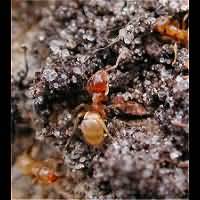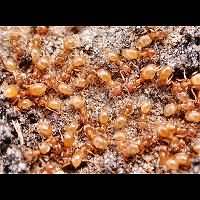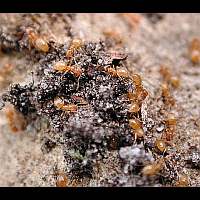[All pictures of garden wildlife on this page are thumbnails. Click on any thumbnail for a large format to be displayed.]

Yellow meadow ant (Lasius flavus)
| Taxonomy | ||||||
|---|---|---|---|---|---|---|
| Kingdom: | Phylum: | Class: | Order: | Family: | Genus: | Species: |
| Animalia | Arthropoda | Insecta | Hymenoptera | Formicidae | Lasius | L. flavus |
The Yellow Meadow Ant is a common species, but rarely seen. This is due to the fact that the species lives underground mainly. Sometimes you disturb a nest when mowing the lawn. From time to time you will see the ant hills. These hills (up to some 50 cm, usually much smaller) are build against the stems of grasses, or against the stems of Wild Thyme, a plant that readily grows in the ant's nest. The Yellow Meadow Ant is a very specialised species, for it keeps root aphids and mealybugs. Keeps? Yes, for the ants milks the aphids. In autumn the ants will transport the aphid eggs into the nest, where the eggs overwinter. The aphid larvae even hatch inside the nest. And in spring when conditions are good, the larvae are transported back to the plants they live on! The workers are highly variable in size: somewhere between 2 to 5 mms. We call this kind of variable workers polymorph. That is a classy word, meaning they may be rather small or rather big. The small workers usually take care of the queen and the nest, the big ones usually milk the aphids and transport them about. The males are bigger (5 to 7 mm) and the queens maybe op to 9 mm long. The winged males are black and the queens are brownish, but certainly darker than the workers are.
In the beginning some queens may work together founding the nest. But once the nest is taking shape, there remains only one egg producing queen. The nests of the Yellow Meadow Ant can be very large indeed, containing up to 100,000 individuals. The species is quite common in Europe, Northern Asia and the North East of America. The bite of this animal is not very painful. Still they may be a nuissance, for there are many of them and often you discover sitting in a nest when it is too late.

© Copyright 1998-2024 gardensafari.net (Hania Berdys)

 English / engels
English / engels  Dutch / nederlands
Dutch / nederlands


